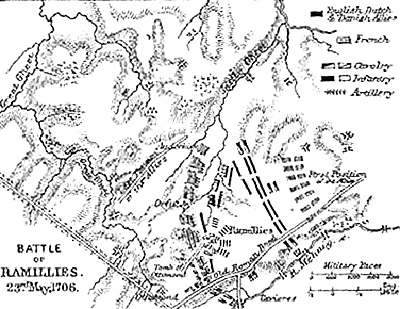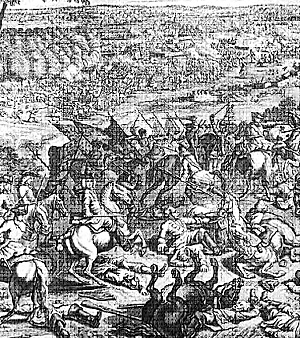By 1706 Prince Eugene was fighting the French in northern Italy, and Marlborough planned to meet him and defeat the French in the south, except that the French ruined his plans. The result was the Battle of Ramillies in what is now Belgium.
 The village of Ramillies lay in the middle of the French lines. The River Geet covered the French left, and their right flank rested on the River Mehaigne. Marlborough began with an impressive attack, again led by his red-coated English, against the French left. They forced their way across the River Geet, and the French threw their reserves against the English.
The village of Ramillies lay in the middle of the French lines. The River Geet covered the French left, and their right flank rested on the River Mehaigne. Marlborough began with an impressive attack, again led by his red-coated English, against the French left. They forced their way across the River Geet, and the French threw their reserves against the English.
On the British right center was some high ground. Well, at least it was high enough to cover the movements of men on horseback. Marlborough used that to shift his English cavalry from his right to his left to attack the French Right flank. Marlborough went so far as to personally lead repeated charges against the French.
Once their cavalry was broken, the English wheeled around the French and rolled up their lines as if they were an old rug. Again, the French were ruined and in retreat. Again, Marlborough was victorious.
In 1708, following a political crisis at home, Marlborough lay sick in bed in Belgium. Harsh Dutch rule had caused several key Belgian fortress cities of Ghent and Bruges to revolt and rejoin the French. These two cities dominated the logistical communications of the area. Marlborough’s army could not move.
Having to leave his army on the Rhine to hold the French, Prince Eugene, with little more than a cavalry escort, dashed to the north to join Marlborough. He convinced him to lead his army to battle by making a dash to save Oudenarde from the French.
 In an age when a ten-mile march was considered a good accomplishment for a day, Marlborough’s men marched 50 miles in 65 hours. In an age when armies carefully deployed before engaging, Marlborough and Eugene went straight at the French. The French Army under Vendome was deployed on high ground overlooking the River Scheldt. Marlborough threw himself into the uneven struggle in the center. Eugene took the right. General Overkirk, as his troops came up, looped far around to Marlborough’s left, and as dark was falling, nearly joined hands with Eugene’s attack from the opposite flank. Nearly surrounded in the dark, as many French managed to escape as were captured, but the French Army was soundly defeated and set on the run.
In an age when a ten-mile march was considered a good accomplishment for a day, Marlborough’s men marched 50 miles in 65 hours. In an age when armies carefully deployed before engaging, Marlborough and Eugene went straight at the French. The French Army under Vendome was deployed on high ground overlooking the River Scheldt. Marlborough threw himself into the uneven struggle in the center. Eugene took the right. General Overkirk, as his troops came up, looped far around to Marlborough’s left, and as dark was falling, nearly joined hands with Eugene’s attack from the opposite flank. Nearly surrounded in the dark, as many French managed to escape as were captured, but the French Army was soundly defeated and set on the run.
Marlborough was all for bypassing the great French fortress of Lille, and pushing into France and on to Paris. Eugene, the younger of the two but the more conservative, urged caution, so they set down to besiege the great fortress of Lille. Marlborough had one army besieging Lille, while another held off any relieving French Army. In the meantime, the French cut Marlborough’s communications with Holland. Marlborough now sought to supply himself by sea through Ostend. The French opened the sluices at Dunkirk, flooding the countryside. Marlborough was now reduced to shipping his supplies to Ostend from England, transferring his supplies to small boats to traverse the flooded areas, and then to wagons to being his supplies to the siege at Lille. Marlborough and Eugene persevered. Lille fell.
Marlborough’s last great victory came in 1709 at Malplaquet. Louis XIV refused to come to the peace table, so the allies massed an army of 110,000 men against 90,000 French, and at Malplaquet, Marlborough and Eugene went into the breach one last time together. The position was naturally strong, and the French had fortified it until it was unassailable. That was where the dynamic duo attacked.
Malplaquet was a village at a gap between the Wood of Taisnieres on the left and the Wood of Lanieres on the right. The entire gap was heavily fortified. The fortifications extended off into the woods on both sides. Marlborough attacked the woods on both sides of the gap. The fierce, bloody fighting in the woods sucked in all of Villars’ and Boufflers’ reserves, leaving the gap at Malplaquet inadequately held. At the proper moment, Marlborough pushed into the gap with a mixed force of cavalry and infantry, and sent the French into retreat once again.
Until the Battle of Borodino, a century later, Malplaquet was the bloodiest battle in history. But alas, the War of the Spanish Succession was not to be won on the battlefield, but at the peace table in Utrecht. Never again was the dynamic duo, whose tactical genius and hard fighting had eclipsed the armies of the Sun King, to wage war together.
Back to Novag's Gamer's Closet Spring 2003 Table of Contents
Back to Novag's Gamer's Closet List of Issues
Back to MagWeb Master Magazine List
© Copyright 2003 by Novag
This article appears in MagWeb.com (Magazine Web) on the Internet World Wide Web. Other articles from military history and related magazines are available at http://www.magweb.com